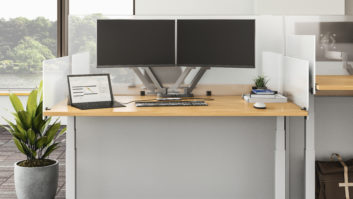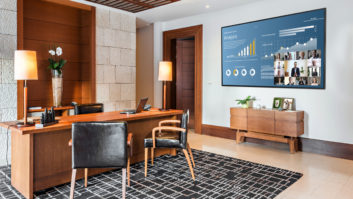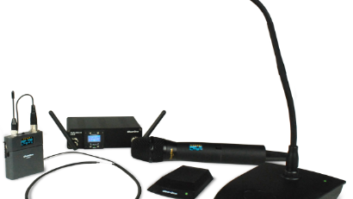When businesses sent staffs to work from home at the beginning of the pandemic, many employees came to the stark realization that their home office setups were not going to cut it…and that’s being generous. Fortunately, the fix was the same as for all the other tech- and convenience-related issues in the home — call in a trusted custom installer.
Whether it was a stronger network, better lighting, or do-not-disturb automation scenes, integrators came to the rescue to provide an effective work environment in the home. As much as they could, anyway — clients getting caught in their underwear on a Zoom call or having pets interrupt meetings goes beyond the CI’s purview.
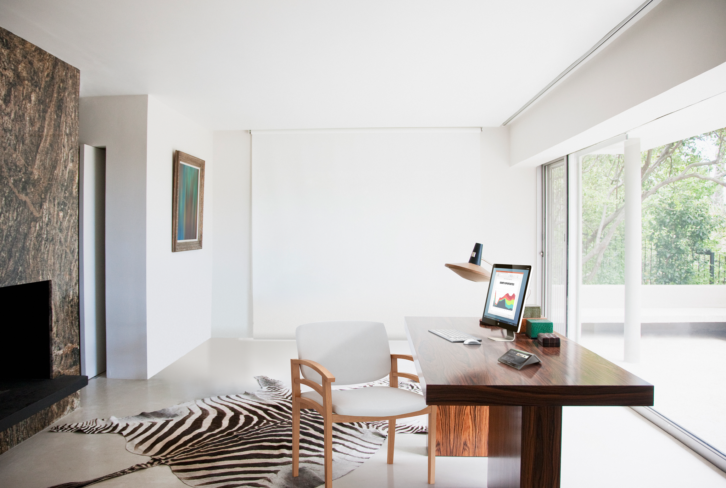
Once the initial mania subsided, however, it was clear that the home office is an area of opportunity for integrators — even more so now that many companies have adapted a hybrid approach where employees can work from home a few days each week and head to the office for the others.
Christopher Piechota, owner of Christopher William, a New York City-based lifestyle technology design and integration firm, used the brief March 2020 slowdown to re-think his young business, which he opened in 2019, and decided to add home office as an option on his website.
“We needed a break to reinvent a couple of things, including home office,” he says. “That was a very light part of what we would do prior, but we never fully invested too much time in it because it wasn’t a consistent want. That all changed with Covid, and it came along with requests for more lighting and more shades. So now home office is one of the things that we get calls for, and it has been working out really well for us.”
Just as media room setups changed dramatically when integrators got involved, so, too, does the potential for what a home office can be, as well as how it can perform. “We want to be more involved in the overall environment and be able to dictate not only look and feel, but also the mood and mental stability,” says Piechota. “With Covid, the home office became a bigger notion, and clients would ask what we can do, so we started brainstorming and looking at product lines such as the Crestron Flex platform and what they were doing in the classic office setting and how we could bring it home.”
Client Wants and Needs
According to Piechota, the starting point is the same as it would be for any project — listening to what the client wants and delivering on that, while making suggestions that support their vision and not coming off as overly “salesy.” It will also likely be a group effort between the usual suspects — interior designers — but also the client’s employer.
As an example, Piechota offers the home office he installed for a friend who works for Goldman Sachs. “My friend said he needed to take his setup at the Goldman Sachs office and re-make it at his house, and he did not want to hear a pin drop in that room,” he says. “That’s pretty specific, so we got some pictures of the existing setup and we reviewed what was realistic and what was not. We worked with his designer and said, ‘We want to get your vision from an aesthetic standpoint, but we have to have the functionality behind it.’
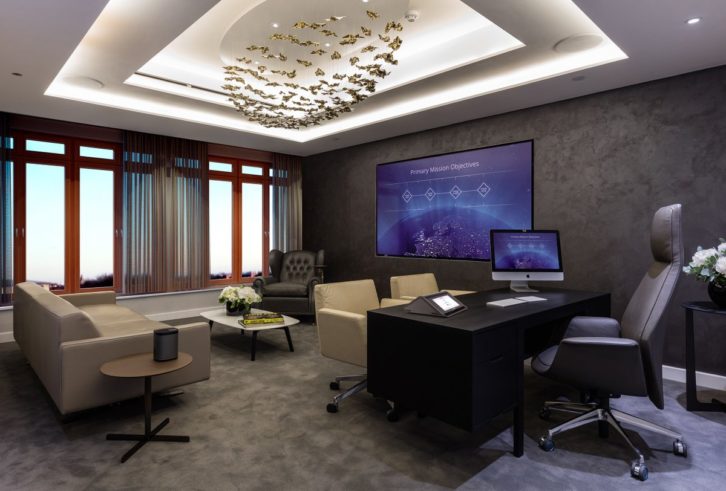
In addition to the designer’s requests, CW also used commercial monitor mounts and mixed in the gear sent from the company. “When the pandemic first went down, companies just shipped equipment and had the homeowners put it together themselves,” says Piechota. “We wound up working with IT departments and had to hand over certain things from a security standpoint; we had to exit the room, if you will.”
He was also able to soundproof the room without being too invasive — thanks to a good soundproofing partner (and much to the designer’s delight) — and added automated locks on the door to ensure privacy during meeting times. “We try to create that type of isolation, privacy, and security for each home office that we that we do,” he adds.
With isolation and security handled, CW turned to functionality and comfort. “We created a tabletop touchscreen that gave him one button to get his initial computer setup with the right functionality and dropped the lights down 15 percent because his screens were hitting him in such a way all day, every day, where the room’s lighting couldn’t counterbalance. So, we were setting the mood and the right atmosphere. Temperature control for the room was a key second step.
“We also ended up switching out the desk, which was custom-made, but we put a motorized sitting/standing solution in there. Then music came up because, between the hours of 12:30 and 2:00 PM, he needed to relax but still stay within his space. We placed invisible speakers in the wall and custom-painted over them. We gave him control from the same tabletop interface where he could control his screen setup.”
Two months later CW was called back to the home to add a television to the room. Again, keeping the aesthetics in mind, they used Leon’s Moving Art Screen to place the television behind a framed piece of art that would move out of the way when the screen was in use.
Building a Better Backbone
Any room has the potential to be a home office, and many rooms become them whether they started as a spare bedroom or sewing room. Creating a dynamic technology-laden space out of one that was planned for minimal or even none has the potential to leave integrators quite a few challenges to overcome.
“For me, it always starts with infrastructure,” says Piechota. “From a planning standpoint, initial dimensions, power, and networking infrastructure are key. The more time you spend in the planning stage, the less time you’re going to spend in the service stage. You need to figure out what are the obstructions, what are the barriers, and what is going to be your biggest hurdle.
“We’re learning as much as we can about the environment, talking with the building general managers and in-house contractors, asking what they have — and haven’t — been seeing, and then also keeping in contact with our vendors for possible solutions.”
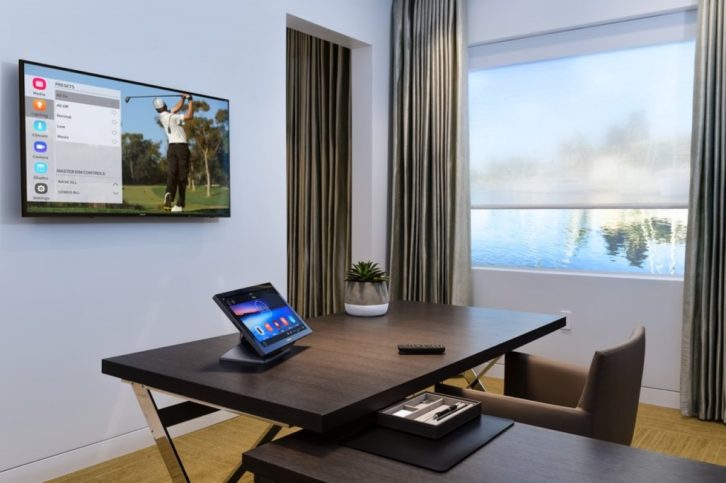
Naturally, one of the most important features of a home office is a strong, reliable network, and that’s where the right vendor partner can make a huge difference.
“We use Araknis fairly consistency for our networking,” says Piechota. “We use their access points along with Ruckus, and I have nothing but great things to say about Ruckus. But we will call Araknis and say, ‘We don’t want the salesman answer here — we want the down and dirty.’ We need to know what’s behind the scenes. If the 510 is totally screwed within this type of environment, we need to know because this is what we’re dealing with.
“We’ve also started using Wilson Electronics cellular boosters, and their rep, John Gully, insisted on coming to the site to make sure the product was right for the situation. I had no problem with that — come on in!”
As far as power management goes, CW uses Wattbox with OvrC and are keeping an eye on Crestron’s latest power strips.
To Zoom or Not to Zoom
Without a doubt, the current home office will be the source of many video calls that all need to run flawlessly. And though the videoconference platform of choice typically comes from an employer, it is something the integrator will have to live with.
“We don’t sell brands, we sell solutions,” says Piechota. “If a client needs to do videoconferencing, we ask, ‘What’s comfortable for your clients and for your company?’ If they have a contract with Microsoft Teams, then we have to use that in whatever way they want — like if they also have RingCentral and want to be able to switch over to full Teams and incorporate their phones. We could do that. The beauty of Crestron is that, especially when we’re getting into custom, we could always say yes and then find a way to do it.
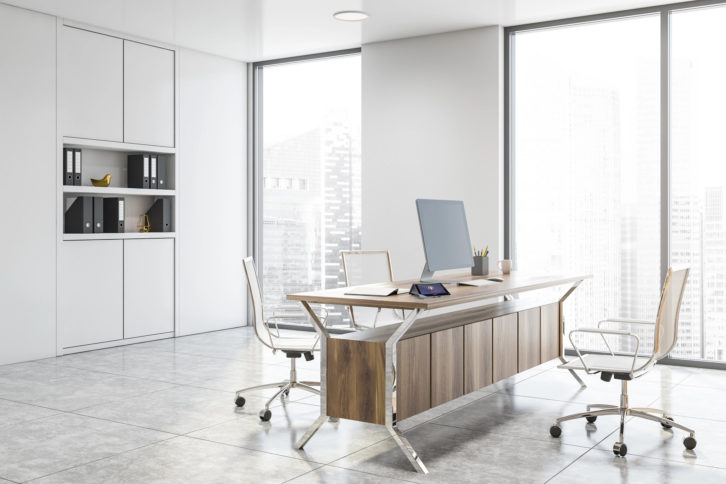
“When it comes to the home office, you have to be very strategic about how you’re going to deliver the interface that they are going to be using and what will be their first button press each day. At the end of the day, there’re so many different solutions out there that you have to draw a line in the sand and say, ‘This is the way that we’re going to go.’”
Here to Stay
Home offices may have been pushed into the spotlight by the pandemic, but now that people are paying attention, Piechota thinks it is here to stay — which presents another opportunity for custom installers.
“Home office has been a great addition to the business,” he says. “In the beginning we knew that, yes, technically we could do it, but we never highlighted it. Now we’re very much used to it, and we can show clients what we can offer. Home office is one of those things that we pivoted to due to the times and now it is more of a foregone conclusion that we’re going to do something within this space.
“It really just comes down to asking how much of your budget is dedicated to the home office? What are you looking for? How creative do you want to get within the room?
“Probably the best question to ask is, ‘How much time are you actually spending in the home office?’ If you’re in the same room constantly, those walls are going to close in real fast. You want to make it as enjoyable as possible.”
Home Office Perspectives
CI industry views on the growing role of home office.
Distributor — ADI Global Distribution
Garrett Savage, U.S. Director of Category Management, ADI Global Distribution
From the start of the pandemic, dealers were forced to reposition their business focus on the technologies that became more prevalent during this time — and ADI has been there to help them.
As more people work from home, there is an increased need for home office technologies that’s driving new opportunities. And the remote and hybrid workplace is expected to continue well into the future, creating continued demand home office technologies.
Some of the key technologies to consider in building a home office include:
- Home Network and Strong Wi-Fi — High-speed and strong internet connectivity is the backbone of working from home, especially when supporting multiple devices across the home. Whether installing a traditional router or a mesh Wi-Fi system, providing a reliable wireless network throughout the home is vital.
- Videoconferencing Technologies — Conferencing solutions can offer communication with superior audio and video capabilities for Zoom meetings, Microsoft Teams sessions, Google chats, and beyond. To enhance the digital experience, consider higher-resolution web conferencing cameras, quality microphones, and additional pro AV products.
- Smart Home Technologies — Smart home technologies allow customers to automate their daily routine and customize their environment for ultimate comfort and productivity while having access to their smart home and security solutions all from one place.
Additional technologies that are important in providing a complete home office solution include power supplies, displays and monitors, mounts, headphones, speakers, cybersecurity tools, storage and cloud-based solutions, cables and charging adapters, and more.
To capitalize on this market, integrators should understand the needs of their customers and work with their distribution partner to design and build the home office experience. Additionally, standardizing on a home office offering can help make future installations easier to sell and install.
Manufacturer — RTI
Bill Hensely, Head of Global Marketing, RTI
Today’s home office not only doubles as the virtual boardroom, but it must also integrate seamlessly with the rest of the smart home. So, as we compete for bandwidth with other members of the household and a range of IoT devices, network management technologies have become essential. And with spaces like dining rooms and family rooms now serving double duty, the ability to quickly adjust a room’s settings between the two functions is paramount. This can easily be achieved with a customizable control system through the creation of one-touch scenes like “Work Mode” or “Family Mode,” which can be enabled with a simple press of a button on a handheld remote or tap of an icon on an in-wall touchscreen.
When it comes to elevating home office functionality, KVM switches are key. These solutions allow workers to turn their laptops into full-blown workstations by connecting them to larger monitors, full-size keyboards, mice, storage devices, and more. Lighting and shading systems also play a role. Not only can they replicate the natural lighting cycle in the home to improve our wellbeing, but they can also be programmed with lighting scenes to help us focus. And how many of us actually end up looking our best on Zoom calls? The right lighting can help with that, too.
Finally, technologies are needed to promote a work-family balance. In homes with video distribution systems, this can be achieved by programming them to deliver all-work content to a room’s primary monitor during office hours, and all-play content after hours. Going a step further, a full-motion TV/monitor wall mount allows a room’s monitor to face one way during work and another for watching TV and movies during the evening and weekends. So, while working in a home office may take a little getting used to, the technology is there to ensure we work productively while maintaining a healthy work-home separation.
Anthony Savona is the content director for Residential Systems and the VP/Content Creation for Future plc’s B2B — AV Tech Group, which includes industry-leading brands such as Systems Contractor News, Sound & Video Contractor, AV Technology, AV Network, Mix, and TWICE.



